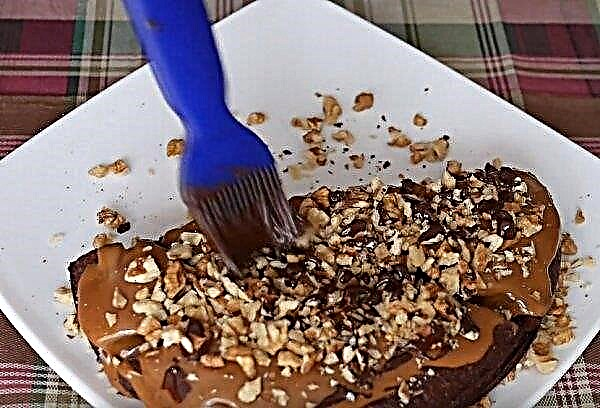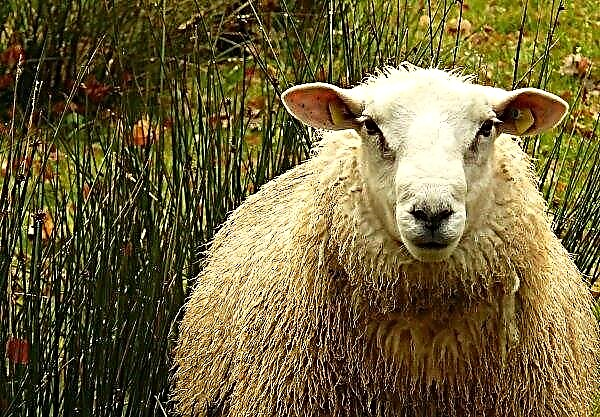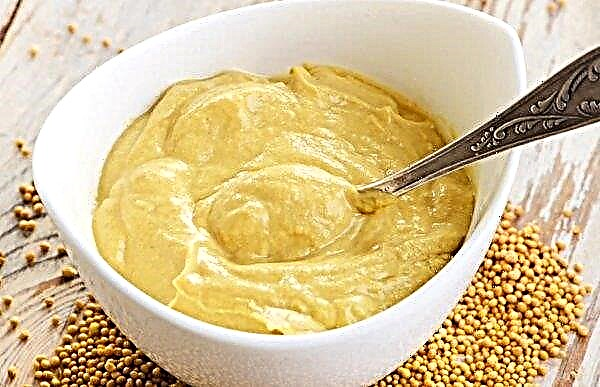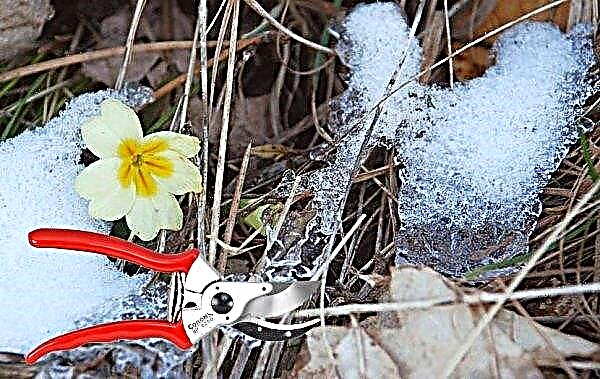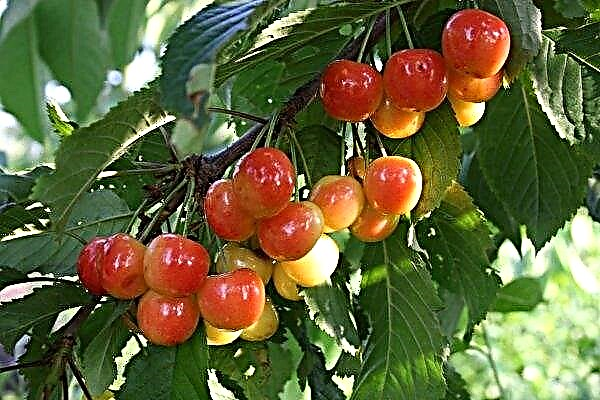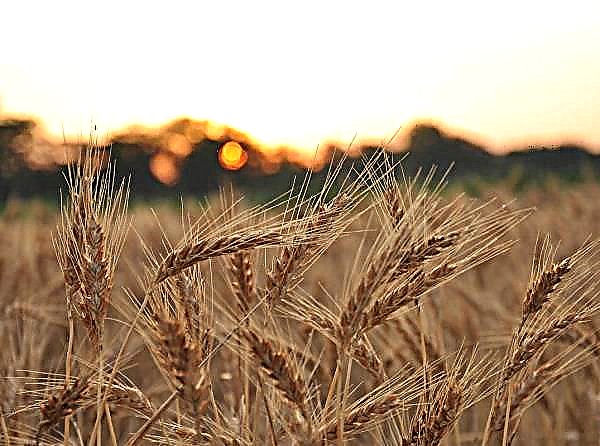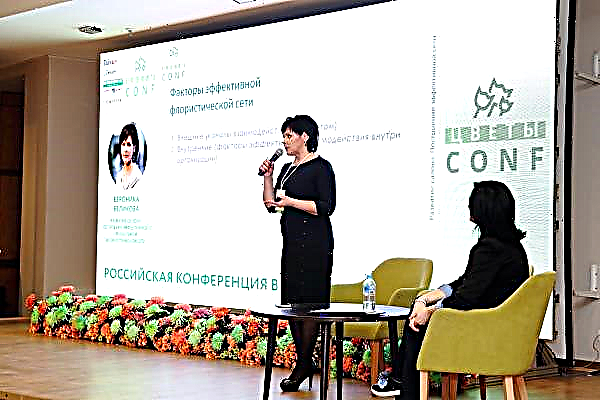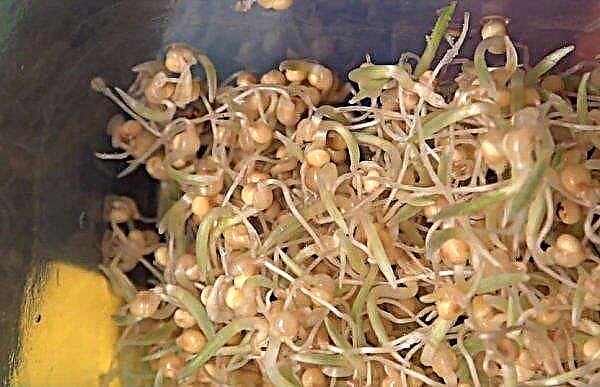Of all the meat breeds of chickens that are known today in the world, brama is among the most popular. Admittedly, this species is worthy of such attention. All about poultry pomfret, including information about bird care and the features of its breeding, in the review below.
Breed description
There are several varieties of pomfret that differ in their appearance and direction of use (in addition to excellent meat qualities, some representatives of the breed are grown as decorative and even fighting).
Divide the brahm also in color. This criterion allows you to select at least four separate lines. However, the Americans, who are considered to be perhaps the most ardent admirers of the breed, prefer breeding grouse. All bremas, regardless of color, are massive, large and beautiful hens with dense plumage and proud posture.
Did you know? In English, the name of the breed is written as “brahma” and comes from the Brahmaputra River, which is the left tributary of the Ganges (moreover, it is one of the largest waterways of South Asia).
Appearance
Indeed, the bream breed, like many other most successful breeds of chickens, owes its origin to the Chinese and Indians. However, the American breeders nevertheless gave the final look to the modern breed, adding to the source material - the Asian leggy chicken - the blood of the Cochin, Chittagong and fighting Malay:
However, the American breeders nevertheless gave the final look to the modern breed, adding to the source material - the Asian leggy chicken - the blood of the Cochin, Chittagong and fighting Malay:
| Appearance | Features, characteristic |
| Head | Proportional, with a wide forehead. The ears are small, elongated. |
| Crest | Small but dense and fleshy. Three row. The teeth are not clearly expressed, the shape of the comb resembles a pea pod. |
| Beak | Powerful and short, bright yellow. |
| Eyes | Set deep and hidden under overhanging eyebrows, which gives the impression of a heavy and somewhat frown "sullen". |
| Neck | Medium in size, gracefully curved, with a characteristic fold in front. The roosters are covered with thick plumage, similar to a lion's mane. With back and tail creates a curved line in the form of a lyre. |
| Chest | Wide, with a high landing, stands forward. |
| Stomach | Dense, wide, powerful, rounded. |
| Wings | Large and strong, rounded in shape. |
| Tail | Lush and short. Sticks up in the shape of a fan. |
| Paws | Long and strong. Covered with a thick plumage, similar to bloomers, especially dense from the back. A characteristic feature is that the middle finger does not stand out among the others in length. |
| Plumage and color | The feathers are very thick, soft, but at the same time durable. They fit tightly to the skin. In hens, the plumage throughout the body is colorful, pastel tones with a beautiful golden tint and a fancy partridge pattern (in the upper part of the body the general tone is darker, in the lower it is lighter). In roosters, the back is bright red, the lower part of the body, the tail and legs are contrast black, with a greenish sheen. |
Did you know? Interestingly, at the stage of the formation of the breed, its productive indicators were much more impressive. So, roosters gained weight up to seven kilograms, and the sexual maturity of the laying hens was already at the age of five months. However, over time, in breeding work, there was a distinct bias towards the decorative qualities of pomfret, as a result of which the size and precocity of the bird suffered a little.
Character
The massive dimensions of the brama determine its nature. The wildness and increased activity of this breed are not characteristic: both the rooster and the laying hen are usually leisurely and sedate, as though they are full of feelings of importance and awareness of their own irresistibility. Despite the blood of fighting roosters flowing in the veins of the brama, the breed did not inherit the aggressiveness of its ancestors. Brahms are quite friendly, easily make contact and are tamed, thanks to which, as a parallel direction of their use, it is first of all necessary to call decorative (although these phlegmatic and stately creatures look like a real decoration on a regular home yard).
Despite the blood of fighting roosters flowing in the veins of the brama, the breed did not inherit the aggressiveness of its ancestors. Brahms are quite friendly, easily make contact and are tamed, thanks to which, as a parallel direction of their use, it is first of all necessary to call decorative (although these phlegmatic and stately creatures look like a real decoration on a regular home yard).
Advantages and disadvantages
- The undoubted advantages of partridge "Americans" include their following features:
- large sizes, making the breed suitable for use in the meat direction;
- general unpretentiousness to the content and feed;
- high resistance to cold (due to magnificent plumage, the bird will not freeze even with significant minus readings of the thermometer and can be kept in unheated rooms without stopping egg production);
- strong immunity and excellent vitality (in adult birds, mortality does not exceed 10%, in young animals it is about 30%);
- good adaptability to the proposed conditions;
- suitability for confinement in a limited space without walking;
- bright decorative qualities;
- calm and accommodating character.
- Among the shortcomings of the breed are usually distinguished:
- relatively low rates of egg production and rather late maturation;
- prolonged period of egg production (during the first year, the breed produces very small eggs, not suitable for incubation);
- very slow weight gain (applies to young animals);
- increased susceptibility to infection by skin and feather parasites (a kind of payment for too thick plumage);
- the need to be kept separate from other breeds to maintain baseline;
- the need for an incubator for eggs or for a layer of lighter breed for hatching (heavy chickens with all their high maternal qualities simply press their own eggs, thereby causing considerable losses to the farmer);
- the high price of breeding birds and the difficulty of their acquisition.
Important! Traditionally, bram (including partridge) is bred only in small farms and on private farmsteads. These birds are not suitable for large-scale industrial livestock breeding, since highly profitable production is based on a shorter cycle of young growth.
Maintenance and care
Care for partridge brahma is not particularly difficult, however, the determining factor that must be taken into account by the farmer is the large size of this bird. But her meek and calm disposition, on the contrary, can significantly save both on the size of the house and on the installation of some additional equipment necessary for the maintenance of more active and lightweight “options”.
But her meek and calm disposition, on the contrary, can significantly save both on the size of the house and on the installation of some additional equipment necessary for the maintenance of more active and lightweight “options”.
Chicken coop
Despite the phlegm and heaviness, the bramas do not tolerate the content in the cells and require a full house.
The following requirements are imposed on him:
- sizes. The standard calculation of the size of the house for sedentary meat breeds of chickens involves placing on one square meter from two to four birds. Thus, for a herd of 20 partridge brams, it is necessary to allocate a room with an area of 5-10 square meters;
- flooring. The most environmentally friendly and at the same time warm material remains wooden boards;
- temperature condition. Chickens feel best in the range from + 23 ° C to + 25 ° C, however in winter they can easily withstand lower rates. If there is good thermal insulation, special heating for the house can be omitted;
- lighting at least twelve to fourteen hours a day. To do this, large windows should be provided in the room, and in winter - additional lighting should be provided (for each square meter of area, 4 to 6 watts of light will be required);
- dryness. The lavish plumage makes the partridge grouse particularly vulnerable to various parasites, which breed in large numbers in a humid environment;
- ventilation. Air stagnation is another factor contributing to the development of pathogenic microorganisms. However, circulation must be ensured in such a way that the inhabitants of the house are not exposed to drafts;
- litter. The floor can be lined with hay, peat, straw or sawdust, which should be changed regularly to avoid the development of pathogenic microflora in them. The wooden floor can not be paved in summer (this will save money and simplify the cleaning process). However, in winter, the litter plays a heating role, so you can not do without it (and in an unheated house, the layer of such insulation should be about 12 cm).
- on three sides of the house, nests (three to five per hen) and perches. The height of their location for large chickens should be at least 40 and a maximum of 50 cm from the floor. The width of the perch should allow the bird to comfortably accommodate. This requires at least 30 cm.
In addition to nests and perches, in the room where the brahma is kept, there must be special bathtubs for dry bathing. They need to be filled with a mixture of fine sand and ash or ash (1: 1 ratio). This will help protect the luxurious plumage of chickens from parasites.
Walking yard
Partridge pomfret, like other heavy meat-style chickens, can be kept without free walking, however, if there is such an opportunity, it must be used.
The benefits of patio equipment for walking are mutual, and here's why:
- the chicken enjoys walking; as a result, the productive qualities of the bird increase, its immunity strengthens;
- the farmer has the opportunity to seriously save on feeds, since a significant part of his diet will be obtained by the chicken on its own (moreover, it is not only about green feeds, but also about the protein component - various kinds of worms, bugs and other small animals).
There is another plus. It is noted that the meat of chickens allowed to free-range is much tastier than that of birds that spend their whole lives indoors. Since brahma is a meat chicken, this argument is of paramount importance.
Did you know? Many farmers are well aware that the place where the hens graze very quickly takes the form of “scorched earth”. This fact often forces the owners to deny their feathered herd the right to walk. Meanwhile, the problem has a different, elegant and witty solution: in the territory where there was a courtyard for walking chickens, the most beautiful English lawns are obtained. It’s enough to just plant lawn grass on such a site, and others have already taken care of removing weeds with roots and seeds.
It is very easy to organize walking for the partridge pomme, as a heavy and slow bird has its own characteristics:
- does not require a large walking area;
- not able to fly even through a low fence.
 In the courtyard it is only important to provide a shaded place where birds can hide from rain, snow or the scorching sun. This is where you should place the feeders, drinking bowls and baths for dry bathing.
In the courtyard it is only important to provide a shaded place where birds can hide from rain, snow or the scorching sun. This is where you should place the feeders, drinking bowls and baths for dry bathing.In summer, Brahms can walk outdoors all day. In winter, walking time should be limited, but they should not be completely stopped (in any case, if the air temperature outside the house has not dropped below -10 ° C).
Feeding troughs and drinking bowls
Pouring food onto the floor of the house, as some homeowners still do, is generally an unsuccessful idea. In this case, chickens peck their own droppings with food, which significantly increases the risk of infectious diseases (such as, for example, coccidiosis).
In addition, the host will be forced to throw out most of the feed along with the change of litter, which makes the maintenance of an already not too cost-effective brama too expensive.
Important! Stimulating a lazy and sedentary drama to active movements by the need to find food is much more correct by arranging a courtyard for walking than by using the entire chicken coop as a feeder.
It is precisely because of hygiene requirements that feeders and drinking bowls in the chicken coop do not just have to be provided. It is also important that, using them, the birds are deprived of the opportunity to climb into the tank.
To do this, the equipment is installed at a height corresponding approximately to the level of the chest of an adult bird. As a material for the feeder, you can use:
As a material for the feeder, you can use:
- plastic pipes;
- plywood boxes;
- plastic containers;
- improvised items (buckets, plastic bottles).
Important! According to generally accepted sanitary standards, each adult chicken requires a minimum of 10 cm of its own space in front of the feeder.
As for drinking bowls, experts recommend not saving and purchasing ready-made nipple-type devices. Then the water in the birds will always be clean and fresh (a similar design can be made with your own hands).
Herd replacement planned
The peak egg production in partridge pommes occurs in the second and third years of the laying hen's life.
Then, the average annual number of eggs decreases quite noticeably, and subsequently, although the ability to lay a chicken can keep up to ten years, an average of no more than four dozen pieces per year.
Of course, such indicators (three eggs a month) cannot satisfy the needs of even the smallest farms, especially since the cost of feeding the brom is very significant. For this reason, the chicken herd is usually completely renewed once every three years. Roosters show approximately the same age indicators of maximum productivity, so the rule about the frequency of replacement also applies to them.
Roosters show approximately the same age indicators of maximum productivity, so the rule about the frequency of replacement also applies to them.
Did you know? About four thousand eggs are laid in the body of a chicken from birth, while a person has more than a million.
If breeding is not planned, then the cock in the herd is not needed. The presence of a male does not directly affect egg production, although, according to the observations of many owners, under the protection of a rooster, laying hens still feel much more comfortable. However, since this is a meat breed, as a rule, its content still involves the generation of offspring.
The optimal ratio of males and females in a chicken parent flock is this: one rooster per ten layers.
What to feed
Large bramas require more abundant feeding, which significantly increases the cost of their maintenance. In addition, the diet of these chickens also has some differences, without which the declared productivity indicators cannot be counted on.
Adult chickens
It is necessary to feed an adult herd in a balanced manner, however, the basis of the diet - about 14% - should be high-calorie protein foods. Dry food should be alternated with wet (it is better to give it in the middle of the day), but in general, hens should receive such components:
Dry food should be alternated with wet (it is better to give it in the middle of the day), but in general, hens should receive such components:
- grain mixtures (preferably crushed);
- combined feed;
- various mixers using waste from the host table;
- soybean meal;
- green food (in winter - in dried form);
- fresh vegetables and fruits (beets, cucumbers, zucchini, carrots, pumpkin, apples);
- fodder yeast;
- fish or meat and bone meal;
- feeding - fish oil, eggshell, chalk, limestone or small shells (source of calcium);
- other vitamin and mineral supplements.
Important! Boiled potatoes should not be given to chickens; from this product, intestinal upsets occur in birds.
It is also necessary to remember that heavy and lazy shamas have a tendency to gain weight and obesity, therefore it is necessary to strictly monitor that the birds do not overeat and move as much as possible.
A herd kept indoors should be fed three times a day, always at the same time. Water in direct access to birds should be constant. It is important to ensure that it is not too cold (in winter, the contents of the drinkers should be heated).
Chickens
Chicken prawn chickens need to be fed more often than an adult herd. The first ten days of life, the bird is given food every two hours with an eight-hour break at night.Further, until the chickens reach the age of one and a half months, the number of feeds during the day is reduced to five to six times (every three hours). And even after that, up to six months, the chicks should eat at least four times a day.
And even after that, up to six months, the chicks should eat at least four times a day.
As for the diet itself, here it is possible to use several options.
For instance:
- high quality starter feeds;
- crushed grain mixtures (wheat and corn in a ratio of 2: 1);
- Self-made "salad" of boiled eggs, wheat and corn groats and grass mountaineer.
Important! Young adults can be transferred to an adult diet no earlier than six months. A month before this, you should reduce the amount of protein food in order to prevent too fast a set of muscle mass, which is still difficult to hold on to a fragile skeleton.
Regardless of the chosen form of feeding, young birds need to be given only fresh food, and new additives (feed, sprouted grain, vegetables, vitamins) should be introduced gradually into the diet.
It should be borne in mind that the winter diet should be approximately 10-15% larger than the summer diet, since the bird incurs additional energy costs due to the need to maintain its own body temperature in a cold room.
Partridge brews are chickens, the main feature of which could be called true Asian sluggishness, and this quality is manifested not only in character. This cannot but upset the farmers (meaning weight gain and starting the egg production process). But to compensate for such inconveniences, the bramas look very impressive, and the high meat productivity and unpretentiousness of the living conditions make them the invariable inhabitants of a huge number of small household plots.
But to compensate for such inconveniences, the bramas look very impressive, and the high meat productivity and unpretentiousness of the living conditions make them the invariable inhabitants of a huge number of small household plots.

